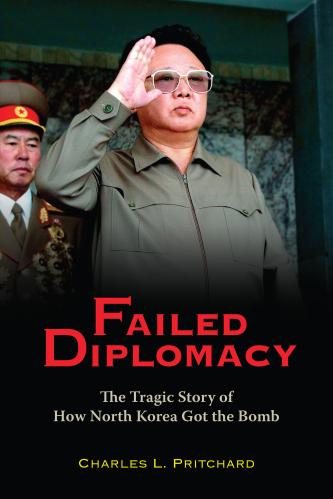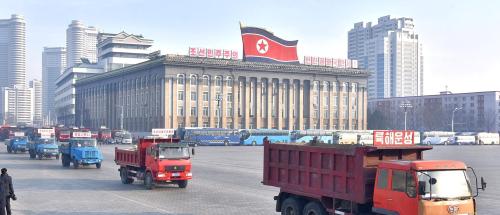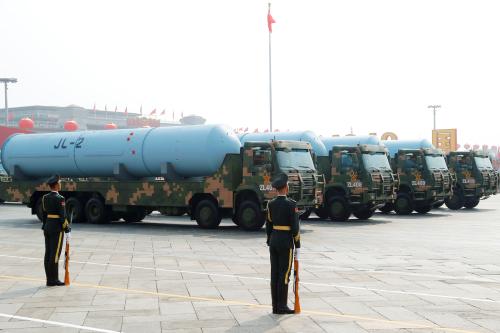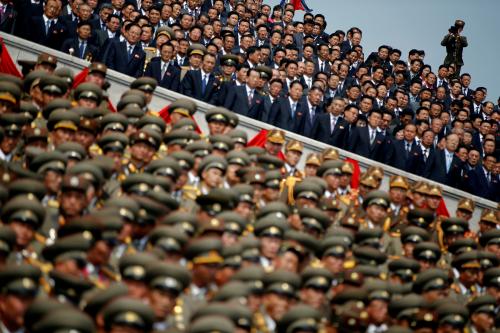Asking South Korea to host any American ground-based intermediate-range surface to surface missiles would be a mistake as it is the kind of stress that the alliance does not need right now, argue Michael E. O’Hanlon and Jung H. Pak. This piece originally appeared in The Hill.
The United States formally withdrew from the 1987 Intermediate-Range Nuclear Forces Treaty with Russia last month. That accord had prohibited all land-based surface to surface missiles, regardless of the type of warhead, with ranges from roughly 310 miles to 3,400 miles.
Within days, new Defense Secretary Mark Esper told reporters that the United States would like to deploy previously banned conventionally armed missiles in Asia in the next few months. Speculation about where they might be based quickly turned to American allies Japan and South Korea. Guam, an American territory in the western Pacific, is close enough that some types of intermediate-range missiles based there could range coastal China, but it is not nearly as close as Japan and South Korea.
A test of a Tomahawk sea-launched cruise missile from a land-based launcher followed, underscoring just how quickly the United States could make good on such aspirations, if so desired. The purpose of any such future American missile deployments would not be to retaliate against Russia for its long standing treaty violations, dating back to the Obama years, that led to the Trump administration decision to leave the INF Treaty. Rather, such missiles would be intended to counter the constantly improving arsenal of perhaps 2,000 Chinese missiles targeted at Taiwan, and potentially at American bases from Okinawa to Guam and beyond.
China was never a party to the INF Treaty, so it has committed no violations with these deployments. But the scale and sophistication of its cruise-missile and ballistic-missile capabilities, together with accurate warheads that in some cases may be capable of not only striking land targets but homing on aircraft carriers, have caused American and allied military planners increasing concern as the years have gone by.
However, asking South Korea to host any American ground-based intermediate-range surface to surface missiles would be a mistake. It is precisely the kind of stress that the alliance does not need right now, as President Trump and President Moon of South Korea seek to cooperate on the key priority of reining in the North Korean nuclear program and as a very strained relationship between Japan and South Korea adds further complications to American strategic missions in Northeast Asia.
Moreover, Seoul is probably reluctant to stir up North Korean ire, as the Moon administration is prioritizing carrots over sticks. The North Korean regime has already warned that the American proposal would start a new Cold War. Thus, such a proposal by the Trump administration would likely produce not new missile deployments, but the kinds of alliance fissures and frictions that North Korea historically specializes in exploiting.
There is no military need for basing intermediate-range missiles in South Korea to threaten North Korean targets. Distances from the region around Seoul to Pyongyang are less than 150 miles, and it is less than 250 miles to the main North Korean nuclear complex. Even shorter distances separate American and South Korean military bases from 80 percent to 90 percent of North Korean conventional military forces, most of which are located within a few dozen miles of the demilitarized zone on the peninsula.
Intermediate-range missiles are, therefore, not needed to put these assets at risk. Indeed, allied aircraft based throughout much of northern South Korea can be within striking range of North Korean targets within around 15 minutes of flight in most cases, and deliver ordnance with accuracy measured in meters or less in all types of weather conditions. The remote northeast of North Korea is more than 300 miles from the demilitarized zone, but the Tomahawk sea-launched cruise missile that the United States is converting into a land-based version can already threaten any important North Korean military assets from ships and submarines nearby.
Seoul will use these facts to oppose any request for an American missile deployment, we predict, because it values good relations with China and will generally seek to minimize tensions with Beijing on military decisions. Given that alliances come and go, but geography remains immutable, this is a reasonable position for South Korea to take. It will be stuck living next to China for many centuries to come. It already has done so for the two millennia of its existence as a nation, during which time South Koreans have maintained a separate proud culture and polity, yet have generally found ways to avoid conflict with their much larger Asian neighbor.
Yes, South Korea accepted the deployment of American missile defense systems in recent years, even though it displeased Beijing along the way. China saw those defense systems as capable of tracking the flights of its land-based nuclear deterrent force, perhaps creating the initial basis for an American missile defense capability against modest Chinese forces. As such, China orchestrated an unfair economic retaliation against South Korean products, reminding many South Koreans why China is not always a trustworthy friend and why an alliance with the United States is sound policy for diplomatic reasons that go well beyond nuclear weapons.
But the central purpose of American terminal high altitude area missile defense systems deployment was to counter North Korean nuclear missiles that could obliterate South Korean cities in a war. The threat was and is real, and the allied response was justifiable and proportionate. China was in the wrong to object. By contrast, intermediate-range surface to surface missiles based in South Korea would not, as noted above, be needed to strike North Korean targets. These missiles could, however, threaten cities such as Tsingdao and Beijing in northeastern China.
The Chinese missiles that allegedly would be deployed to counter the American missiles are located primarily in southeastern China across the Strait from Taiwan, more than 1,000 miles away in most cases. In theory, some Tomahawk cruise missiles might be able to range that far, but only barely, making South Korea a geographically questionable place for any such deployment. The analogy that American policymakers should now contemplate before asking Seoul to host offensive intermediate-range missiles is not the missile defense systems deployment, but the poorly considered attempt by the Bush administration to request “strategic flexibility” for American forces in South Korea some 15 years ago.
The essence of strategic flexibility was that Washington would have advance approval from Seoul to allow use of American aircraft based in South Korea to strike targets in the broader region. South Korea knew one possible scenario would involve a war between China and Taiwan, with American forces entering the fray to defend the latter. Not knowing which side would have been the cause of any crisis that led to such a war, South Korea declined the American request, in effect saying to Washington, “Before you draw us even indirectly into any fight with China, you better ask us based on the specific circumstances of the issue at hand.”
That episode occurred during the Roh administration, when Moon was presidential chief of staff. He has unlikely forgotten that unfortunate experience, which had only exacerbated an already strained relationship between Seoul and Washington, produced nothing positive in the end.
The Brookings Institution is committed to quality, independence, and impact.
We are supported by a diverse array of funders. In line with our values and policies, each Brookings publication represents the sole views of its author(s).












Commentary
America should not ask South Korea to host intermediate-range missiles
September 5, 2019